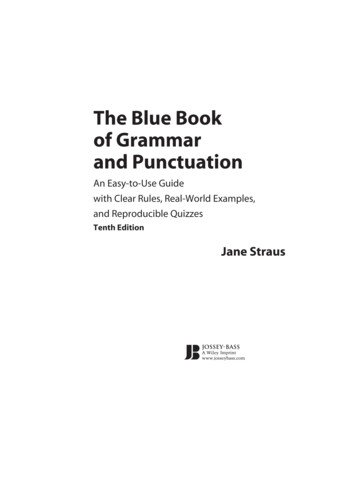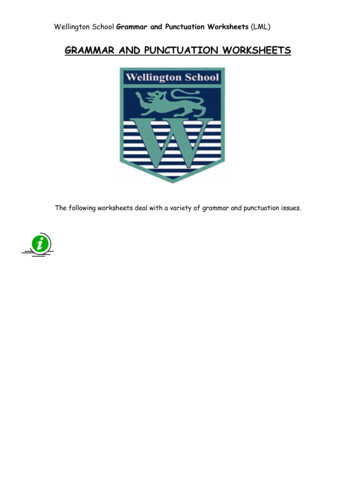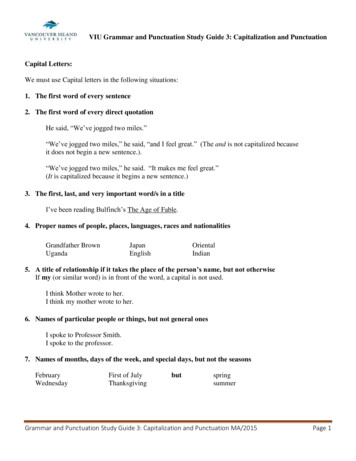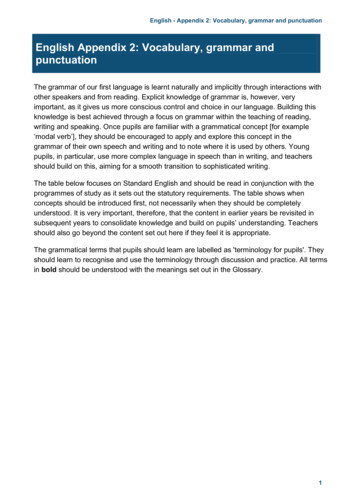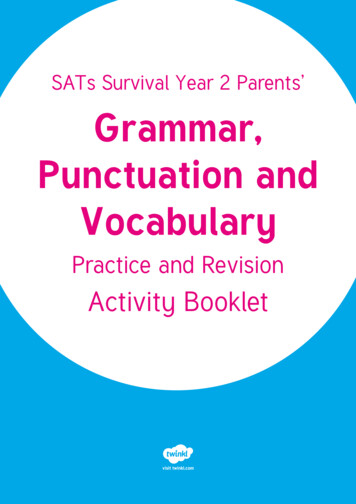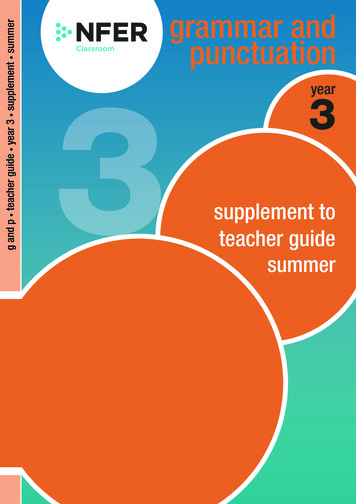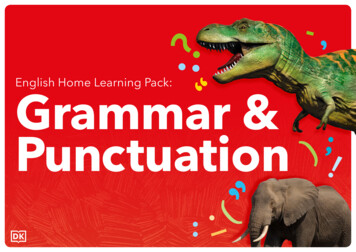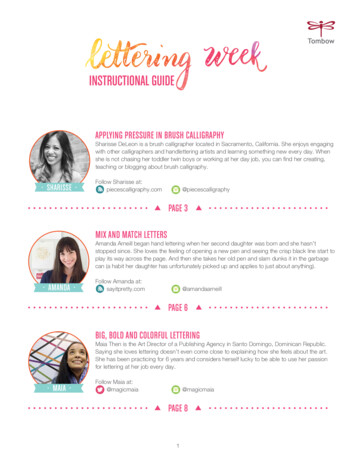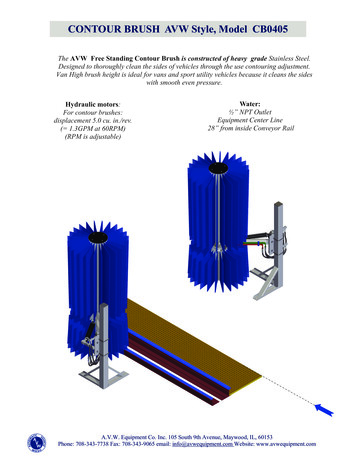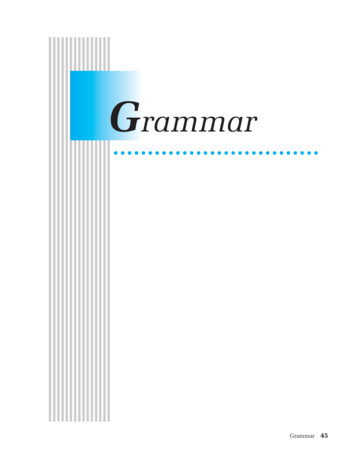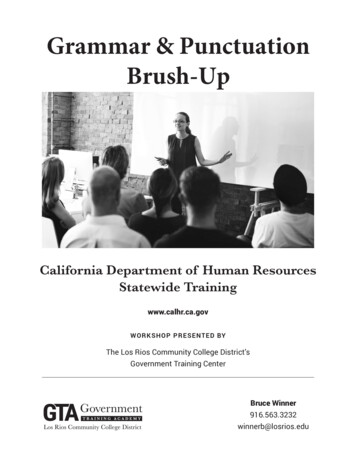
Transcription
Grammar & PunctuationBrush-UpCalifornia Department of Human ResourcesStatewide Trainingwww.calhr.ca.govWOR K S HO P P RES ENTED BYThe Los Rios Community College District’sGovernment Training CenterBruce Winner916.563.3232winnerb@losrios.edu
Table of ContentsSection 1 Overview . 2Section 2 Sentence Structure . 3Section 3 Correcting Common Writing Errors . 11Section 4 Business Writing Style . 22Section 5 Action Plan . 28
Grammar and Punctuation Brush-UpSection 1OverviewOutcomeIncreased ability to write in a way that’s accurate, saves time, and builds yourcredibilityObjectivesUpon completion, participants will be able to: Understand the basics of grammar Avoid the most common word use errors Write more concisely by eliminating unnecessary words Encourage others to read your writing Provide readers what they expect in a professional business documentAgenda1. Overview2. Sentence structure3. Correcting common writing errors Word usage Punctuation4. Business writing style5. Action planPage 2
Grammar and Punctuation Brush-UpSection 2Sentence StructureParts of SpeechUsing the Correct WordsGood grammar begins with using the correct words, which involves anunderstanding of the basic parts of speech.Match the descriptions on the right with the parts of speech on the left.Nouna. A person, place, or thing. It can be the subject orobject of a sentence (e.g., cat, horse, Lodi).Pronounb. A word that describes or modifies a noun. Itanswers questions like “how many” or “what kind”(e.g., happy, red, dangerous).Verbc. A word that describes or modifies a verb (e.g.,carefully, quickly, wisely).Note: Adverbs usually, but not always, end in “ly”.Not every word ending in “ly” is an adverb:“friendly,” for example, is an adjective.Adjectived. A word that replaces or stands for (“pro” for) anoun (e.g., I, you, he, she, it, we, they).Adverbe. A word that indicates the relationship of a noun (ornoun phrase) to another word (e.g., to, at, in, on,with, for, against, across, between, among,through).Prepositionf. An action word (e.g., sit, laugh, run).Page 3
Grammar and Punctuation Brush-UpPutting Words TogetherPutting words together correctly is just as important as choosing the correct words.Consider the following sentence: “I saw a teacher who cares.”The author may have meant: “I saw a teacher. Who cares?”Using periods (and other forms of punctuation) and knowing when to end asentence are very important. If you don't end a sentence appropriately, the intendedmeaning can be changed or misunderstood.Although you don’t need to remember all of the terms below, a basic understandingis crucial and will help you later in the class when we consider some of the mostcommon sentence errors.Match the descriptions on the right with the terms on the left.Phrasea. The basic unit of writing that has a subject and averb.Prepositionalphraseb. An expression that contains a single thought, but isnot necessarily a complete sentence. Words makeup phrases; phrases make up sentences.Sentencec. A phrase that is acting like a sentence, but isincomplete. When a sentence ends too quickly, it iscalled this.Note: These are acceptable as answers to directquestions:“Where is my hat?” “In the bushes.”Run-onsentenced. A sentence that should be broken into two or moresentences.Sentencefragmente. “I am sitting in the bushes.” “I am sitting” is acomplete sentence unto itself; it contains a subject(“I”) and a verb (“am sitting”). “In the bushes”expands upon the basic concept.Page 4
Grammar and Punctuation Brush-UpSentencesRun-on SentencesA run-on sentence is common and is particularly frustrating for readers. There areseveral ways to fix a run-on; we will consider three common fixes below.Method #1Write the two independent clauses (group of words that contains a subject and verband expresses a complete thought) as separate sentences using periods.INCORRECTCORRECTCarmen loved traveling in Italy she felt Rome was too hot.Carmen loved traveling in Italy. She felt Rome was toohot.Method #2Use a semicolon to separate the two independent clauses. (We’ll learn more aboutsemicolons later today.)INCORRECTCORRECTCarmen loved traveling in Italy she felt Rome was too hot.Carmen loved traveling in Italy; she felt Rome was toohot.Method #3Use a comma and any a FANBOYS connecting words: for, and, nor, but, or, yet, so.INCORRECTCarmen loved traveling in Italy she felt Rome was too hot.CORRECTCarmen loved traveling in Italy, but she felt Rome was toohot.ExerciseFix these run-ons using one of the methods above.1. The girls played basketball the boys played tennis.2. Mother's Day is always on a Sunday Thanksgiving is always on a Thursday.3. William loved visiting San Francisco Sally preferred just to stay in Sacramento.Page 5
Grammar and Punctuation Brush-UpSubject-Verb AgreementOne of fastest ways to lose credibility as a writer is to make an error regardingsubject-verb agreement. In every sentence, the subject and verb must agree innumber. This means if the subject is singular (a single person or thing), then theverb must also be in singular form. The trick is recognizing the singular or pluralform of verbs.Beware: A common mistake is thinking that if a verb has an –s on the end, it isplural. Adding an –s to the end of a noun may make it plural, but that is not alwaystrue for verbs.When to use the –s (or –es) form of a present-tense verbIs the verb’s subject he, she, it or one?YESUse the –s form (loves, tries, has, does).YESUse the –s form.YESUse the –s form.NOIs the subject a singular noun (such ashamster)?NOIs the subject a singular indefinitepronoun – anybody, anyone, each,either, everybody, everyone, everything,neither, no one, someone, or something?NOUse the base form of the verb (such aslove, try, have, do).Exception: Choosing the correct present-tense form of be (am, is, or are) is notalways so simple.To beSingularPlural1st personI amWe are2nd personYou areYou are3rd personHe/She/It isThey arePage 6
Grammar and Punctuation Brush-UpSubject-Verb Agreement ChallengesThere are times when subject-verb agreement isn't so easy and clear. Rememberthis rule: It is the subject that determines the verb. Take a look at this exampleand choose the correct verb:My friend from Tokyo who has lots of dogs and cats is/are a computergenius.What is the subject? My friend from Tokyo.Is My friend from Tokyo singular or plural? It is singular. Therefore, use is.Here are some rules that will help you keep subject-verb agreement in even morechallenging sentences.Rule #1Use a singular verb after each, either, neither, everyone, everybody, nobody,and someone.Nobody is here.Everybody helps when there is a crisis.Somebody wants to speak to you.Rule #2If you use either-or, look at the subject closest to the verb. If the subject closest tothe verb is singular, use a singular verb; likewise, if the subject is plural, use a pluralverb.Either Miss Brown or Jane writes on the blackboard.Either the teacher or the students write on the blackboard.This rule also applies to not only/but also, and neither/nor. The subject closest tothe verb determines whether the verb is singular or plural.Not only Julie but also Georgette wants to visit Grandma.Page 7
Grammar and Punctuation Brush-UpRule #3When using as well as, except, in addition to, no less than, and with, the nounbefore these phrases determines the number.Ford in addition to Mercedes Benz is lowering its car prices to encouragebetter sales.The students in addition to the teacher are all receiving special recognitionfor their excellent research.Rule #4Measurements of money, time, and distance usually require a singular verb.One hundred dollars is a lot of money for a bottle of wine.Two hours is a long time to wait to see a doctor.93,000,000 miles is the distance from the sun to the earth.Rule #5The following words almost always use the plural form of verbs: all, both, few,many, several, and some.Some people in my office are very annoying.Few mountain climbers have successfully reached the peak of Mt. Everest.Page 8
Grammar and Punctuation Brush-UpRule #6Here and there cannot be subjects. Therefore, if a sentence begins with here orthere, look for the subject and write the correct form of the verb.Here is my jacket. (The word jacket is singular.)Here are my shoes. (The word shoes is plural.)Rule #7When the word number is preceded with the word a, use a plural verb. When theword number is preceded with the word the, use a singular verb.A number of people are waiting to see you.The number of stars in the sky seems countless.Page 9
Grammar and Punctuation Brush-UpSubject-Verb Agreement Quiz1. There is/are two sides to every argument.2. Several professional sports teams is/are located in California.3. 5,280 feet is/are a mile.4. Either choice is/are acceptable to me.5. Jill as well as Jack is/are/am up the hill.6. Either Heather or I go/goes.7. Ten dollars more per hour is/are a nice raise.8. Either the bus driver or the motorcycle rider is/are/am responsible for theaccident.9. Neither the 23 children in the class nor Tony seem/seems to be upset aboutfailing the spelling bee.10. A large number of countries is/are/am members of the United Nations.11. Not only the fans but also the team's head coach was/were shocked to be in thechampionship game.12. Everybody helps when there is a crisis.Page 10
Grammar and Punctuation Brush-UpSection 3Correcting Common Writing ErrorsCategories of ErrorsThis section on common errors is divided into two main categories: words andpunctuation. The examples in each category do not represent an exhaustive list oferrors, but they do represent the most common errors in general usage.DisclaimerNo two books are in total agreement on the proper use of the English language. Forexample, 30 Days to Better English (Lewis) contradicts Errors in English and Waysto Correct Them (Shaw) on many points. One book strives to preserve moretraditional usage; the other school usually accepts common usage as the evolvingstandard. Most of us are not English scholars and are caught in the middle.If your goal is to be credible with your audience, take the more traditional approach;when in doubt, err on the side of conservatism. Just be careful not to appear toostuffy or constrained in your writing style.Word UsageFor an exhaustive list of hundreds of word usage infractions, go tohttp://www.wsu.edu/ brians/errors/. This website, authored by Paul Brian who is anEnglish Professor at Washington State University, has many useful tools and linksfor helping “avoid low grades, lost employment opportunities, lost business, andtitters of amusement at the way you write or speak.”affect, effectMost commonly, affect is a verb meaning “to influence” and effect is a nounmeaning “result”.I would like to affect your attitude so you have a positive effect on myemployees.Exception:Page 11
Grammar and Punctuation Brush-Upa, anThe choice between these two words depends on the initial sound of the word thatfollows. An should be used before a vowel sound and a should be used before aword with a consonant sound.As an adult, it is an honor to serve as a museum docent.among, betweenAmong refers to groups of more than two persons or things; between refers to onlytwo.Greater emotional intelligence is listed among the benefits of reading herbook.The relationship between Jason and Vince has been strained for years.beside, besidesBeside is a preposition that means “next to.” Besides is an adverb that means “inaddition to.”Put the file cabinet beside the desk.Besides the new cabinet, we need better lighting.can, mayCan implies ability; may indicates permission.I can take your order states ability.May I take your order? asks permission to take the order.capital, capitolCapital should be used in all situations except when you’re talking about a buildingor structure.In Sacramento, the state capital, there is an informative tour that passes bythe capitol. The tour is inexpensive; it doesn’t take much capital.Page 12
Grammar and Punctuation Brush-Upcomplement, complimentComplement means to complete or go well with. Compliment means to give praiseor to give something free of charge.Anything chocolate is a complement to a tall glass of milk.My boss gives compliments about once a year.counsel, councilCouncil means an assembly or group. Counsel is a noun (advice given or anattorney) and a verb (to advise).The city council will counsel you to drop the case.criteria, criterionCriteria is the plural form of criterion, a standard on which a judgment is made.The most important criterion in the pie judge’s mind was taste.The exclusive club has a long list of membership criteria.discreet, discreteDiscreet means showing good judgment or modest; discrete means distinct orseparate.The new school principal mandated studious, discreet attire.The sage’s counsel was discrete from his behavior.ensure, insureTo ensure that something happens is to “make certain” that it does, and to insure isto “issue an insurance policy”.Please ensure that you will insure your son.farther, furtherFarther refers to physical distance; further means to a greater extent, or additionaltime, quantity, or degree.When we discussed it further, we realized that the students ran farther thanusual.Page 13
Grammar and Punctuation Brush-Upgood, wellGood is an adjective, never an adverb. Well is nearly always an adverb; when usedto indicate state of health, well is an adjective.Good work should be intrinsically rewarding.I’m feeling well today, thank you.imply, inferImply means “to suggest, hint, or communicate indirectly”; infer means “to deduceor conclude from”. Writers and speakers imply; readers and listeners infer.I thought she was implying that I was attractive to her; apparently I inferredincorrectly.it’s, itsIt’s is the contraction of “it is” or “it has”. Its is the possessive form of “it”.It’s usually cold in Alaska.That museum of antiquities finally modernized its collection.lay, lieLay means “to put or place something”.Never again lay your dirty socks on the table.She finally laid down the law with that Casanova.Lie means “to rest or recline”.Li’l Abner has to lie down for work. He lay down yesterday after he arrived forwork.principle, principalPrincipal means a sum of money or a chief person. Principle is a governing truth.The principal of that school was a woman of principle.Page 14
Grammar and Punctuation Brush-Upreal, really, veryReal is usually used as an adjective meaning authentic. Do not use it in place of theadverbs very or really.Real life is tough and then you die.Real life is very (not real) difficult.their, there, they’reTheir is a possessive pronoun. As a pronoun, there is used to introduce a clause; asan adverb, it is used to indicate place. They’re is the contraction for “they are.”They’re going nowhere unless their homework is completed.I’ll meet you there at 9:00.to, too, twoTo is a preposition. Too is an adverb meaning “also”. Two is a number followingone.The two men were too tired to go.who, whomWho is used as the subject of a clause; whom is used as the object of a verb (directobject) or of a preposition.To whom should I acknowledge a job well done?Do not tell Wilfred, who is usually the last to know about anything.who’s, whoseWho’s is the contraction of “who is” or “who has”. Whose is a possessive pronoun.Who’s responsible for all the changes?Whose ice cream was left out all night?Page 15
Grammar and Punctuation Brush-UpPunctuationBreakout Activity1. Your group has been assigned one punctuation mark. After the 15-minutebreakout session, you'll be asked to present a brief explanation of when to use,and not use, your assigned mark. We'll also ask you to present two sentencesaloud – one that uses the mark correctly, and one that doesn’t.2. Class participants will then identify which is the correct sentence and which isthe incorrect sentence. (Please do not label your sentences "correct" and"incorrect" when you present them.)3. Please use these 15 minutes to prepare the following for your assignedpunctuation mark: a brief explanation of when to use or not use the mark one sentence using the mark correctly one sentence using the mark incorrectlyCommaA comma indicates a pause in the flow of a sentence. Here are guidelines for basiccomma usage.Items in a series – The comma is used to separate three or more equally rankedelements in a list.Example:Richard conducted the research, organized the data, and wrote the report.Direct address – Names and titles are set off with commas.Example:I do believe, Joseph, that you have outdone yourself.Dates – Use a comma to separate the day of the month from the year and after theyear.Example:Melissa met her husband on August 15, 2009, in New York.However, if any part of the date is omitted, do not use a comma.Example:Melissa met her husband in August 2009 in New York.Page 16
Grammar and Punctuation Brush-UpNon-essential phrases in the middle of a sentence – Use a comma before thephrase to indicate the beginning of the pause and another one at the end to indicatethe end of the pause.To decide whether a phrase is non-essential, ask these questions: If I leave out the phrase, does the sentence still make sense? If I move the phrase to a different position, does the sentence still makesense?If you answer yes to either of these questions, the phrase is non-essential andshould be set off with commas.Example:That Friday, which is my anniversary, is the only day I can meet with you.Some words of warning about commasDo not use a comma to replace an omitted word.He said, he would be happy to help. (Wrong: The comma should not besubstituted for that.)Do not use a comma between two independent clauses where a stronger markof punctuation is required. Use a period or semicolon in place of the comma insuch a statement as this:The procedure is complete, you can send it to the others. (Wrong: You need asemicolon.)Do not use a comma before the indirect part of a quotation.The speaker asserted that, he stood squarely for progress. (Wrong: No commais needed after that.)Page 17
Grammar and Punctuation Brush-UpApostropheThis mark of punctuation has three uses: to indicate omission of a letter from aword, to form the possessive case of nouns, and to indicate plurality in specialsituations.Never use an apostrophe in forming the plural of nouns and the possessive case ofpersonal and relative pronouns:Incorrect: The Bundy’s are coming home tomorrow. (Don’t use an apostrophe inBundys.)Incorrect: our’s, ours’, your’s yours’, his’, her’s, it’s, their’s, theirs’, who’s (unlessyou mean who is).Correct: ours, yours, his, hers, its, theirs, whose.Use an apostrophe and s to form the possessive case of a noun (singular or plural)not ending in s:women, women’schildren, children’shospital, hospital’shorse, horse’sUse an apostrophe to form the possessive case of a plural noun ending in s:ladies, ladies’students, students’heroes, heroes’Use an apostrophe alone or an apostrophe and s to form the possessive of singularnouns ending in s:Jack Williams, Jack Williams’ (or Williams’s)Page 18Dennis, Dennis’s
Grammar and Punctuation Brush-UpSemicolonThis mark of punctuation is often ignored. Instead of using the semicolon, manypeople use the colon and the dash. The most common semicolon error is to not useit when it should be used. The two ways you should use a semicolon in businesswriting are to link and separate.LinkWe regret that we have sold all of the blue shirts; however, we have the samestyle in white.SeparateThese students were nominated for the award: Todd Smith, Santa Rosa; CarlosFrisco, Napa; and Megan Perkins, Vallejo.ColonThe colon informs the reader to watch for a list or tabulation that will fulfill what hasjust been promised. Phrases such as “here are” and “the following” are examples ofthis anticipatory language.There were three notable rock bands without bass players: The Doors, ZZTop, and Thin Lizzy.Some words of warning about colonsDo not place a colon between a preposition and its object.I am fond of: New York, Washington, and Miami. (There is no need for thecolon or any other mark of punctuation after of.)Do not place a colon between a verb and its object.He liked to see: TV plays, movies, and baseball games.She liked a number of activities, such as: dancing, cooking, and swimming.Page 19
Grammar and Punctuation Brush-UpDashThere are three ways to use a dash; each way uses a distinct mark with a differentname and a different length.Em dash ( — )You can create an em dash in Microsoft Word using the following keystrokecombination: CRTL ALT Minus sign (on numeric keypad).Spacing: Use without a space on either side—as shown here.Use an em dash: For an abrupt change in thought in a sentence. To set off a complete phrase that includes a series of words with commas.Example:She named the reasons she liked working there—flexibility, fun, and travel.En dash ( – )You can create an en dash in Microsoft Word using the following keystrokecombination: CRTL Minus sign (on numeric keypad).Spacing: Use without a space on either side, like this: 2006–07.Use the en dash to indicate: A range of inclusive numbersExamples: pages 67–71; 2013–2014The minus sign in an equation Negative numbersDo not use a dash in expressions when the word from or between appears.Examples:From May to June (NOT from May–June)Between 2006 and 2013 (NOT between 2006–2013)Hyphen (-)Use a hyphen if ambiguity would result without it.Challenge: Where should the hyphens go?Come see the six foot man eating chicken.Page 20
Grammar and Punctuation Brush-UpTest Your GrammarTest Your GrammarWrite the best choice below the sentences.1. His tie (complements / compliments) his suit and shirt nicely.2. (Who / Whom) shall I say is calling?3. Each of the reports (contain / contains) several errors.4. The policy will (effect / affect) only part-time employees.5. The report is not ready today ( , ; ) however ( , ; ) we’ll send it out tomorrow.6. The city (council/counsel) will (council/counsel) you to drop the case.7. City (managers / manager’s) have the authority to veto the budget.8. Hard work and attention to detail (is / are) her greatest strengths.9. Melissa met her husband in August (comma / no comma) 2009 in New York.10. There were two notable rock bands without bass players (: / ;) The Doors andProcol Harum.Page 21
Grammar and Punctuation Brush-UpSection 4Business Writing StyleStyle DifferencesThe diversity of opinion widens when it comes to writing style because style is amatter of personal preference. Some writers prefer William Strunk and others preferHarry Shaw. Rather than take a particular position, the following pages reflect acomposite business writing style from many sources.Sentence LengthGuideline: Avoid sentences of more than 25 words. And, vary your sentence lengthfor interest. Your co-workers will not read long documents with long sentences.Look for long sentences and, if possible, shorten them by using simpler words andbreaking up the sentences with appropriate punctuation.Instead son most occasionsin the event thatcommenceand so on and so forthat a later datein order toany and alleach and everyPage 22
Grammar and Punctuation Brush-UpActive and Passive VoiceGuideline: Use the active voice instead of the passive voice. (This does not meanthat the writer should entirely discard the passive voice, which is sometimesnecessary.) The active voice is more direct and vigorous than the passive, and thatsuits the assertive and no-nonsense style of business writing.Write or edit the sentence so that the subject performs the action expressed in theverb.Example:The dog bit the boy.-instead of- The boy was bitten by the dog.Here’s the way to determine if any sentence is written in active or passive voice:1. Find the verb.2. Determine who or what is performing that verb.3. Determine if that who or what appears first in the sentence. If not, it’s passivevoice and should be transformed to active voice.ExerciseRewrite the following sentences using the active voice.1. My first vacation in Hawaii will always be remembered by me.2. Mistakes were made.3. A census of this region was made in 1900.4. The trash was removed from the construction site.5. The land was stripped of timber before the settlers realized the consequences oftheir actions.Page 23
Grammar and Punctuation Brush-UpPowerful VerbsGuideline: Don’t use a noun when a powerful verb is better. Sentences will beshorter and more powerful. Look for verbs that have been turned into nouns.Examples:Write “recommend” instead of “make a recommendation.”Write “agree” instead of “reach an agreement.”ExerciseIn each of following examples, the verb has been disguised as a noun. Circle theweak noun and replace with a strong verb. Rewrite the sentence if necessary.1.We gave careful consideration to this proposal.2.He made reference to recent data from the XYZ Corp.3.Jones was not successful in making contact with the XYZ sales reps.4.The accountant performed an audit on the accounts.5.He gave an indication which format he had a preference for.Page 24
Grammar and Punctuation Brush-UpConcrete WordsGuideline: Use specific wording for concrete expression instead of general wordingthat impacts clarity. Abstract words, like abstract art, are open to the reader’sinterpretation. Look for words or phrases that could be misinterpreted or could slowdown the reader.Example:Write “by noon tomorrow” instead of “as soon as possible.”ExerciseRewrite the following general words/phrases with more specific words that leaveless room for interpretation.1. You will enjoy considerable savings with this purchase.2. Certificates of deposit are for large amounts and short maturities.3. Security must be strengthened.4. We will soon offer extended banking hours.5. Buy Deep Doze sleep aid. Works great in a short time.Page 25
Grammar and Punctuation Brush-UpEliminate ClichésGuideline: Try to be more original by not using clichés and worn-out expressions.Clichés, used too often, make your writing stale and trite. Also, they can confusereaders whose second language is English. When you see clichés in your writing,take them out and substitute plain English words that convey the same meaning.Example:Write “try something new” instead of “think outside the box.”ExerciseRewrite the following clichés with plain words that mean the same thing.1. Avoid it like the plague2. Like pulling teeth3. Between a rock and a hard place4. Leading edge5. The whole nine yards6. Hold his feet to the fire7. Drill down8. Crossing that bridge when we come to itPage 26
Grammar and Punctuation Brush-UpConsistencyGuideline: Use consistent words and phrases in documents that are technical innature. Using different words for specific or technical terms will confuse andfrustrate your readers; they assume the words have different meanings.Example:Use “hard drive” throughout your document, instead of shuffling among“memory,” “storage,” and “hard drive.”ExerciseFind the inconsistent terms on the PowerPoint slide.ParallelismGuideline: Writing all the similar parts of a sentence in the same way. Lookespecially at your lists within sentences and bulleted lists to ensure each thing listedis the same part of speech.Example:Jerry likes drafting complaints, issuing subpoenas, and to argue in a courtroom.ExerciseFix the lack of parallelism in these sentences.1. Children who study music also learn confidence, discipline, and they arecreative.2. Emily Dickinson’s poetry features the use of dashes and capitalizing commonwords.3. Before your camping trip, you should: Buy insect repellant Washing your sleeping bag Notification of your nearest relative about your camping location Check your water supply and food reserves A back-up plan in case you get caught in a stormPage 27
Grammar and Punctuation Brush-UpSection 5Action PlanDescribe at least two ways you will use the skills you gained in this class.ActionDateResources:Books1. Andrus, Carol. Fat-Free Writing. Crisp Publications.2. Bowman, David. Precise Edit. PreciseEdit.com3. Brock, Susan. Better Business Writing. Crisp Publications.4. Meyer, Sebranek, and Van RysStraus. Write for Business. Upwrite Books.5. Shaw, Harry. Errors in English and Ways to Correct Them. Harper Collins.6. Strunk and White. Elements of Style. Pearson Education.Websites http://www.myenglishteacher.net/previous.html http://owl.english.purdue.edu/owl/Page 28
Grammar and Punctuation Brush-Up Page 7 Subject-Verb Agreement Challenges. There are times when subject-verb agreement isn't so easy and clear. Remember this rule: It is the subject that determines the verb. Take a look at this example and choose the correct verb: My friend from Toky
